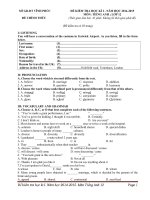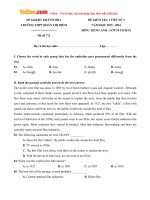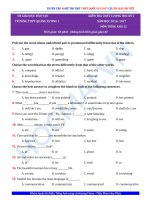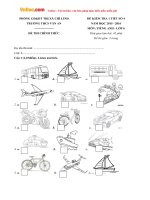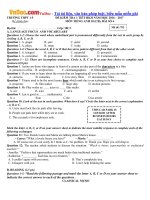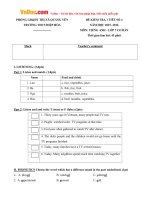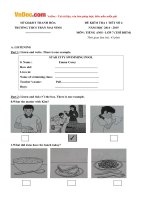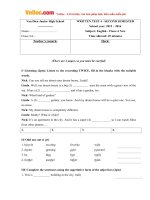ĐỀ THI HỌC KÌ 1 – ĐỀ SỐ 4 MÔN: TIẾNG ANH 11 GLOBAL SUCCESS
Bạn đang xem bản rút gọn của tài liệu. Xem và tải ngay bản đầy đủ của tài liệu tại đây (532.25 KB, 20 trang )
ĐỀ THI HỌC KÌ 1 – ĐỀ SỐ 4
MÔN: TIẾNG ANH 11 GLOBAL SUCCESS
BIÊN SOẠN: BAN CHUYÊN MÔN LOIGIAIHAY.COM
Exercise 1. Choose A, B, C or D to indicate the word whose underlined part differs from the other three
in pronunciation in each of the following questions.
1. A. healthy B. fitness C. strength D. mental
2. A. control B. economic C. confidence D. condition
Exercise 2. Choose A, B, C or D to indicate the word that differs from the other three in the position of
the primary stress in each of the following questions.
3. A. model B. design C. reduce D. impact
4. A. community B. leadership C. experience D. develop
Exercise 3. Choose A, B, C or D to indicate the correct answer to each of the following questions.
5. Although global warming is causing changes in weather patterns, it is only one aspect of ________.
A. global warming B. ecological balance
C. climate change D. carbon footprint.
6. The crash resulted ________ the death of 10 passengers.
A. to B. at C. into D. in
7. The medical authorities warned everyone not to drink the water without _______it.
A. being boiled B. boiling C. having boiled D. having to boil
8. You need to _____________ a community project related to the theme for the year
A. reject B. reach C. approve D. propose
9. His girlfriend _________________ gentle and independent
A. acts B. seems C. says D. Look
10. Most people will use public _____________ such as trams and electric buses
A. places B. technology C. transport D. system
11. Each generation is likely to have different thoughts about how the family__________ interact.
A. should B. must C. have to D. could
12. Living under the same roof with three or four generations can be frustrating because of the lack of space,
independence, and the daily ________
A. arguments B. debates C. conflicts D. quarrel
13. If you want to have a long, healthy life, you need to exercise to have a good level of ___________.
A. intelligence B. activities C. weight D. fitness
14. Topics such as genders and drugs, which used to be avoided in family conversations are now more
_______.
A. common B. popular C. prominent D. dominant
Exercise 4. Choose A, B, C or D to indicate the correct response to each of the following exchanges.
15. Nam: What are the main threats to the environment today? ~ Lan: "___________"
A. Threats are possible dangers to the environment.
B. Probably deforestation and global warming.
C. Environmental pollution is a big issue for our planet.
D. We need a clean environment to live in.
16. -Nancy: “I think school days are the best time of our lives.” - James: “____________. We had sweet
memories together then.”
A. I’m afraid so B. Absolutely. C. That’s nonsense D. I doubt it
Exercise 5. Complete the following sentences with the correct forms of the words in capitals.
17. Madagascar suffers from a high rate of ___________________. (FOREST)
18. The _______________________ for a new high-speed railway met with strong opposition. (PROPOSE)
19. _____________________ will be a key consideration in urban planning and development.
(SUSTAINABLE)
20. My wife is _________________________ for cooking meals. (RESPONSIBILITY)
Exercise 6. Read the following text and choose the best answer to fill in the blanks.
In the year 1900, the world was in the midst of a machine revolution. (21) _____ electrical power became
more ubiquitous, tasks once done by hand were now completed quickly and efficiently by machine. Sewing
machines replaced needle and thread. Tractors replaced hoes. Typewriters replaced pens. Automobiles
replaced horse-drawn carriages.
A hundred years later, in the year 2000, machines were again pushing the boundaries of (22) _____ was
possible. Humans could now work in space, thanks to the International Space Station. We were finding out
the composition of life thanks to the DNA sequencer. Computers and the world wide web changed the way
we learn, read, communicate, or start political revolutions.
So, what will be the game-changing machines in the year 2100? How will they (23) _____ our lives better,
cleaner, safer, more efficient, and more exciting?
We asked over three dozen experts, scientists, engineers, futurists, and organizations in five different
disciplines, including climate change, military, (24) __________, transportation, and space exploration, about
how the machines of 2100 will change humanity. The (25) _____ we got back were thought-provoking,
hopeful and at times, apocalyptic.
(Adapted from />
21. A. Despite B. However C. Although D. As
22. A. what B. that C. who D. which
23. A. notice B. taste C. make D. hope
24. A. structure B. archaeology C. infrastructure D. exaction
25. A. answers B. programs C. contacts D. services
Exercise 7. Read the passage and write A, B, C, D or E next to the statement which contains the
information from the paragraph.
We are a planet of seven billion people, and this number is growing by about 370,000 people every day. This is
putting a huge strain on the planet's natural resources. For many governments and environmental organizations,
the race is on to drastically reduce our consumption of resources before they run out.
Water is one of our most precious resources. Our quality of life, as well as life itself, depends on the availability
of clean, fresh water. It is the most widely used resource in industry and plays a major role in energy
production. Although 70 percent of the world is covered in water, only 2.5 percent of that is fresh water, and
less than one percent of that freshwater is readily available to us. Yet we often overestimate how much water
we have and reduce it further through pollution or inefficient use.
Some 92 percent of all fresh water used annually is dedicated to growing plants and raising animals for food.
This means that if water runs out, our food supply might follow. In India, it is estimated that future water
shortages could reduce grain harvests by 25%. In a country where the population exceeds 1.2 billion people
and is growing rapidly every year, this is a huge concern. India, like many developing countries, is already
struggling to provide for its population. While most people in developed countries can get water at the turn of
a tap, nearly four billion people elsewhere lack access to safe water, according to United Nations Development
Report.
Rain forests are another endangered resource. While rain forests are critically important to humanity, they are
rapidly being destroyed by human activities. The biggest cause of deforestation is conversion of forest land for
agriculture. Often called the "Lungs of the Planet”, rain forests once covered 14 percent of the Earth's land
surface, but this has shrunk to only six percent. Every second, an area of rain forest, the size of a football field,
is destroyed at this rate. Rain forests will possibly disappear completely in less than 40 years.
(Adapted from: Active Reading)
26. Which best serves as the title for the passage?
A. Resources for the future. B. Human and environment.
C. Awareness of conservation. D. Water pollution
27. The word "strain" in paragraph 1 is closest in meaning to ________.
A. contradiction B. depletion C. harmony D. pressure
28. In paragraph 2, water is one of our most precious resources because ________.
A. most parts of the world is covered in fresh water
B. our quality of life depends on the availability of fresh water
C. fresh water is hardly used for energy production.
D. all freshwater on earth is readily available to us.
29. The word “they” in paragraph 3 refers to_________.
A. rain forests B. humanity C. human activities D. resources
30. Which of the following is NOT true, according to the passage?
A. Most of the fresh water is used to grow plants and raise animals for food.
B. The availability of clean, fresh water greatly affects our quality of life.
C. Our forests, the "Lungs of the Planet”, are increasing quickly.
D. The deforestation has been caused mainly by conversion of forest land for agriculture.
Exercise 8. Complete the sentences without changing the meaning.
31. “Why don’t we go to the cinema?”
=> He suggested ___________________________________________________________.
32. It takes Thanh 3 hours a day to do her homework.
=> Thanh spends ___________________________________________________________.
33. I would like to do the laundry every day.
=> I am interested __________________________________________________________.
34. It is necessary to check your health every six months.
=> Checking ______________________________________________________________.
35. Hoa managed to lose weights to keep in shape.
Hoa succeeded ____________________________________________________________.
Exercise 9. Now, listen and choose the correct answer.
36. The USA burns over 700 million tons of coal/ oil every year.
37. The world used 35.5 billion barrels of oil in 2018/ 2019.
38. Oil consumption goes up/ goes down every year.
39. Vehicle sales in the USA increased/ dropped from 2019 to 2020.
40. We lost 12 percent/ 12.2 percent of rainforest last year.
----------------------THE END----------------------
HƯỚNG DẪN GIẢI
Thực hiện: Ban chuyên môn Loigiaihay.com
1. B 2. C 3. A 4. B 5. C
10. C
6. D 7. B 8. D 9. B 15. B
20. responsible
11. A 12. C 13. D 14. A 25. A
30. C
16. B 17. deforestation 18. proposal 19. Sustainability 40. 12 percent
21. D 22. A 23. C 24. C
26. A 27. D 28. B 29. A
36. coal 37. 2018 38. goes up 39. dropped
31. He suggested going to the cinema.
32. Thanh spends 3 hours a day doing her homework.
33. I am interested in doing the laundry every day.
34. Checking your health every six months is necessary.
35. Hoa succeeded in losing weight to keep in shape.
HƯỚNG DẪN GIẢI CHI TIẾT
1. B
Kiến thức: Phát âm “e”
Giải thích:
A. healthy /ˈhel.θi/
B. fitness /ˈfɪt.nəs/
C. strength /streŋθ/
D. mental /ˈmen.təl/
Phần được gạch chân ở phương B được phát âm /ə/, các phương án còn lại phát âm /e/.
Chọn B
2. C
Kiến thức: Phát âm “o”
Giải thích:
A. control /kənˈtrəʊl/
B. economic /ˌiː.kəˈnɒm.ɪk/
C. confidence /ˈkɒn.fɪ.dəns/
D. condition /kənˈdɪʃ.ən/
Phần được gạch chân ở phương C được phát âm /ɒ/, các phương án còn lại phát âm /ə/.
Chọn C
3. A
Kiến thức: Trọng âm từ có 2 âm tiết
Giải thích:
A. model /ˈmɒd.əl/
B. design /dɪˈzaɪn/
C. reduce /rɪˈdʒuːs/
D. impact /ɪmˈpækt/
Phương án A có trọng âm 1, các phương án cịn lại có trọng âm 2.
Chọn A
4. B
Kiến thức: Trọng âm từ có 3 âm tiết
Giải thích:
A. community /kəˈmjuː.nə.ti/
B. leadership /ˈliː.də.ʃɪp/
C. experience /ɪkˈspɪə.ri.əns/
D. develop /dɪˈvel.əp/
Phương án B có trọng âm 1, các phương án cịn lại có trọng âm 2.
Chọn B
5. C
Kiến thức: Cụm danh từ
Giải thích:
A. global warming (np): sự nóng lên toàn cầu
B. ecological balance (np): cân bằng sinh thái
C. climate change (np): biến đổi khí hậu
D. carbon footprint (np): lượng khí thải carbon
Although global warming is causing changes in weather patterns, it is only one aspect of climate change.
(Mặc dù sự nóng lên tồn cầu đang gây ra những thay đổi về kiểu thời tiết nhưng đó chỉ là một khía cạnh của
biến đổi khí hậu.)
Chọn C
6. D
Kiến thức: Cụm động từ
Giải thích:
result in: dẫn đến
The crash resulted in the death of 10 passengers.
(Vụ tai nạn khiến 10 hành khách tử vong.)
Chọn D
7. B
Kiến thức: Dạng của động từ
Giải thích:
Sau giới từ “without” ta dùng V-ing.
The medical authorities warned everyone not to drink the water without boiling it.
(Các cơ quan y tế khuyến cáo tất cả mọi người không nên uống nước chưa đun sôi)
Chọn B
8. D
Kiến thức: Từ vựng
Giải thích:
A. reject (v): từ chối
B. reach (v): với tới
C. approve (v): chấp thuận
D. propose (v): đề xuất
You need to propose a community project related to the theme for the year.
(Bạn cần đề xuất một dự án cộng đồng liên quan đến chủ đề trong năm)
Chọn D
9. B
Kiến thức: Từ vựng
Giải thích:
A. says: nói
B. seems: có vẻ, dường như
C. acts: hành động
D. look: trông (từ này đang không chia theo chủ ngữ ngơi thứ 3 số ít)
His girlfriend seems gentle and independent.
(Bạn gái anh ấy có vẻ dịu dàng và độc lập.)
Chọn B
10. C
Kiến thức: Từ vựng
Giải thích:
A. places (n): địa điểm
B. technology (n): công nghệ
C. transport (n): giao thông
D. system (n): hệ thống
Most people will use public transport such as trams and electric buses.
(Hầu hết mọi người sẽ sử dụng phương tiện giao thông công cộng như xe điện và xe buýt điện.)
Chọn C
11. A
Kiến thức: Động từ khuyết thiếu
Giải thích:
A. should: nên
B. must: phải
C. have to: phải
D. could: có thể
Dựa vào nghĩa của câu, ta cần điền “should” để diễn tả một lời khuyên.
Each generation is likely to have different thoughts about how the family should interact.
(Mỗi thế hệ có thể có những suy nghĩ khác nhau về việc gia đình nên tương tác với nhau như thế nào.)
Chọn A
12. C
Kiến thức: Từ vựng
Giải thích:
A. arguments (n): thảo luận
B. debates (n): tranh luận chính thức, nghiêm túc về vấn đề (trong quốc hội)
C. conflicts (n): xung đột
D. quarrel (n); cãi nhau về vấn đề cá nhân
Living under the same roof with three or four generations can be frustrating because of the lack of space,
independence, and the daily conflict.
(Sống chung dưới một mái nhà với ba hoặc bốn thế hệ có thể khiến bạn cảm thấy khó chịu vì thiếu không gian,
sự độc lập và những xung đột hàng ngày.)
Chọn C
13. D
Kiến thức: Từ vựng
Giải thích:
A. intelligence (n): trí thông minh
B. activities (n): hoạt động
C. weight (n): cân nặng
D. fitness (n): thể lực
If you want to have a long, healthy life, you need to exercise to have a good level of fitness.
(Nếu muốn có một cuộc sống lâu dài, khỏe mạnh, bạn cần phải tập thể dục để có một thể lực tốt.)
Chọn D
14. A
Kiến thức: Từ vựng
Giải thích:
A. common (adj): phổ biến (tồn tại với số lượng lớn, có mặt, dễ thấy nhiều nơi)
B. popular (adj): phổ biến (được ưa thích, ưa chuộng)
C. prominent (adj): quan trọng, nổi bật
D. dominant (adj): chiếm ưu thế
Topics such as genders and drugs, which used to be avoided in family conversations are now more common.
(Các chủ đề như giới tính và ma túy trước đây thường tránh né trong các cuộc trị chuyện gia đình giờ đây đã
trở nên phổ biến hơn.)
Chọn A
15. B
Kiến thức: Chức năng giao tiếp
Giải thích:
A. Các mối đe dọa là những mối nguy hiểm có thể xảy ra đối với mơi trường.
B. Có thể là nạn phá rừng và hiện tượng nóng lên tồn cầu.
C. Ơ nhiễm mơi trường là một vấn đề lớn đối với hành tinh của chúng ta.
D. Chúng ta cần một môi trường trong sạch để sống.
Nam: What are the main threats to the environment today? ~ Lan: " Probably deforestation and global
warming."
(Nam: Những mối đe dọa chính đối với mơi trường hiện nay là gì? ~ Lan: " Chắc là nạn phá rừng và hiện
tượng nóng lên toàn cầu.")
Chọn B
16. B
Kiến thức: Chức năng giao tiếp
Giải thích:
A. Tơi e là vậy
B. Chắc chắn rồi.
C. Điều đó thật vớ vẩn
D. Tơi nghi ngờ điều đó
-Nancy: “I think school days are the best time of our lives.” - James: “Absolutely. We had sweet memories
together then.”
(Nancy: “Tôi nghĩ những ngày đi học là khoảng thời gian đẹp nhất trong cuộc đời chúng ta.” - James:
“Chắc chắn rồi. Khi đó chúng tơi đã có những kỷ niệm ngọt ngào bên nhau”.)
Chọn B
17. deforestation
Kiến thức: Từ vựng – từ loại
Giải thích:
Sau giới từ “of” cần một danh từ.
forest (n): rừng
deforestation (n): sự tàn phá rừng
Madagascar suffers from a high rate of deforestation.
(Madagascar phải chịu tỷ lệ phá rừng cao.)
Đáp án: deforestation
18. proposal
Kiến thức: Từ vựng – từ loại
Giải thích:
Sau mạo từ “the” cần một danh từ.
propose (v): đề xuất
The proposal for a new high-speed railway met with strong opposition.
(Kiến nghị về một tuyến đường sắt cao tốc mới gặp phải sự phản đối gay gắt.)
Đáp án: proposal
19. Sustainability
Kiến thức: Từ vựng – từ loại
Giải thích:
Danh từ là chủ ngữ đứng trước động từ chính.
sustainable (adj): bền vững
sustainability (n): sự bền vững
Sustainability will be a key consideration in urban planning and development.
(Tính bền vững sẽ là yếu tố quan trọng cần cân nhắc trong quy hoạch và phát triển đô thị.)
Đáp án: Sustainability
20. responsible
Kiến thức: Từ vựng – từ loại
Giải thích:
Cấu trúc: S + be + adj => cần một tính từ chủ động để mơ tả tính chất của sự vật
responsibility (n): trách nhiệm
responsible (adj): có trách nhiệm
My wife is responsible for cooking meals.
(Vợ tôi chịu trách nhiệm nấu bữa ăn.)
Đáp án: responsible
21. D
Kiến thức: Liên từ
Giải thích:
A. Despite + V-ing/ N: Mặc dù
B. However + S + V: Tuy nhiên
C. Although + S + V: Mặc dù
D. As = Because: bởi vì
(21) As electrical power became more ubiquitous, tasks once done by hand were now completed quickly and
efficiently by machine.
(Bởi vì năng lượng điện trở nên phổ biến hơn, các công việc trước đây được thực hiện bằng tay giờ đây
được hồn thành nhanh chóng và hiệu quả bằng máy.)
Chọn D
22. A
Kiến thức: Mệnh đề danh từ bắt đầu với “what”.
Giải thích:
A. what: cái gì
B. that: cái đó
C. who: ai
D. which: cái nào
A hundred years later, in the year 2000, machines were again pushing the boundaries of (22) what was
possible.
(Một trăm năm sau, vào năm 2000, máy móc lại vượt qua ranh giới những gì có thể.)
Chọn A
23. C
Kiến thức: Dạng của động từ
Giải thích:
notice (v): chú ý
taste (v): nếm/ có vị
make (v): tạo ra/ làm nê
hope (v): hi vọng
Cấu trúc: to make sth + adj: làm cho cái gì đó làm sao
How will they (23) make our lives better, cleaner, safer, more efficient, and more exciting?
(Làm thế nào họ sẽ làm cho cuộc sống của chúng ta tốt hơn, sạch hơn, an toàn hơn, hiệu quả hơn và thú vị
hơn?)
Chọn C
24. C
Kiến thức: Từ vựng
Giải thích:
A. structure (n): kết cấu
B. archaeology (n): khảo cổ học
C. infrastructure (n): cơ sở hạ tầng
D. exaction (n): sự đòi hỏi
We asked over three dozen experts, scientists, engineers, futurists, and organizations in five different
disciplines, including climate change, military, (24) infrastructure, transportation, and space exploration,
about how the machines of 2100 will change humanity.
(Chúng tôi đã hỏi hơn ba chục chuyên gia, nhà khoa học, kỹ sư, nhà tương lai học và tổ chức ở năm lĩnh vực
khác nhau, bao gồm biến đổi khí hậu, quân sự, cơ sở hạ tầng, giao thông vận tải và thám hiểm không gian, về
cách máy móc của năm 2100 sẽ thay đổi nhân loại.)
Chọn C
25. A
Kiến thức: Từ vựng
Giải thích:
A. answers (n): câu trả lời
B. programs (n): chương trình
C. contacts (n): liên hệ
D. services (n): dịch vụ
The (25) answers we got back were thought-provoking, hopeful and at times, apocalyptic.
(Câu trả lời mà chúng tôi nhận được đã kích thích tư duy, đầy hy vọng và đơi khi mang tính chất tận thế.)
Chọn A
Đoạn văn hồn chỉnh:
In the year 1900, the world was in the midst of a machine revolution. (21) As electrical power became more
ubiquitous, tasks once done by hand were now completed quickly and efficiently by machine. Sewing
machines replaced needle and thread. Tractors replaced hoes. Typewriters replaced pens. Automobiles
replaced horse-drawn carriages.
A hundred years later, in the year 2000, machines were again pushing the boundaries of (22) what was
possible. Humans could now work in space, thanks to the International Space Station. We were finding out
the composition of life thanks to the DNA sequencer. Computers and the world wide web changed the way
we learn, read, communicate, or start political revolutions.
So, what will be the game-changing machines in the year 2100? How will they (23) make our lives better,
cleaner, safer, more efficient, and more exciting?
We asked over three dozen experts, scientists, engineers, futurists, and organizations in five different
disciplines, including climate change, military, (24) infrastructure, transportation, and space exploration,
about how the machines of 2100 will change humanity. The (25) answers we got back were thought-
provoking, hopeful and at times, apocalyptic.
Tạm dịch:
Vào năm 1900, thế giới đang ở giữa cuộc cách mạng máy móc. Bởi vì năng lượng điện trở nên phổ biến hơn,
các công việc trước đây được thực hiện bằng tay giờ đây được hoàn thành nhanh chóng và hiệu quả bằng
máy. Máy khâu thay thế kim và chỉ. Máy kéo thay thế cuốc. Máy đánh chữ thay thế bút mực. Ô tô thay thế xe
ngựa.
Một trăm năm sau, vào năm 2000, máy móc lại vượt qua ranh giới những gì có thể. Con người giờ đây có thể
làm việc trong không gian nhờ Trạm vũ trụ quốc tế. Chúng tôi đã tìm ra thành phần của sự sống nhờ vào trình
tự sắp xếp DNA. Máy tính và world wide web đã thay đổi cách chúng ta học, đọc, giao tiếp hoặc bắt đầu các
cuộc cách mạng chính trị.
Vậy, những cỗ máy thay đổi cuộc chơi vào năm 2100 sẽ là gì? Làm thế nào họ sẽ làm cho cuộc sống của
chúng ta tốt hơn, sạch hơn, an toàn hơn, hiệu quả hơn và thú vị hơn?
Chúng tôi đã hỏi hơn ba chục chuyên gia, nhà khoa học, kỹ sư, nhà tương lai học và tổ chức ở năm lĩnh vực
khác nhau, bao gồm biến đổi khí hậu, quân sự, cơ sở hạ tầng, giao thông vận tải và thám hiểm khơng gian, về
cách máy móc của năm 2100 sẽ thay đổi nhân loại. Câu trả lời mà chúng tôi nhận được đã kích thích tư duy,
đầy hy vọng và đơi khi mang tính chất tận thế.
We are a planet of seven billion people, and this number is growing by about 370,000 people every day. This
is putting a huge strain on the planet's natural resources. For many governments and environmental
organizations, the race is on to drastically reduce our consumption of resources before they run out.
Water is one of our most precious resources. Our quality of life, as well as life itself, depends on the availability
of clean, fresh water. It is the most widely used resource in industry and plays a major role in energy
production. Although 70 percent of the world is covered in water, only 2.5 percent of that is fresh water, and
less than one percent of that freshwater is readily available to us. Yet we often overestimate how much water
we have and reduce it further through pollution or inefficient use.
Some 92 percent of all fresh water used annually is dedicated to growing plants and raising animals for food.
This means that if water runs out, our food supply might follow. In India, it is estimated that future water
shortages could reduce grain harvests by 25%. In a country where the population exceeds 1.2 billion people
and is growing rapidly every year, this is a huge concern. India, like many developing countries, is already
struggling to provide for its population. While most people in developed countries can get water at the turn of
a tap, nearly four billion people elsewhere lack access to safe water, according to United Nations Development
Report.
Rain forests are another endangered resource. While rain forests are critically important to humanity, they are
rapidly being destroyed by human activities. The biggest cause of deforestation is conversion of forest land
for agriculture. Often called the "Lungs of the Planet”, rain forests once covered 14 percent of the Earth's land
surface, but this has shrunk to only six percent. Every second, an area of rain forest, the size of a football field,
is destroyed at this rate. Rain forests will possibly disappear completely in less than 40 years.
(Adapted from: Active Reading)
Tạm dịch:
Chúng ta là một hành tinh có bảy tỷ người và con số này đang tăng thêm khoảng 370.000 người mỗi ngày.
Điều này đang gây áp lực rất lớn lên tài nguyên thiên nhiên của hành tinh. Đối với nhiều chính phủ và tổ chức
môi trường, cuộc chạy đua nhằm giảm đáng kể mức tiêu thụ tài nguyên của chúng ta trước khi cạn kiệt đang
diễn ra.
Nước là một trong những tài nguyên quý giá nhất của chúng ta. Chất lượng cuộc sống của chúng ta, cũng
như bản thân cuộc sống, phụ thuộc vào nguồn nước sạch và trong lành. Đây là nguồn tài nguyên được sử
dụng rộng rãi nhất trong công nghiệp và đóng vai trị chính trong sản xuất năng lượng. Mặc dù 70% thế giới
được bao phủ bởi nước nhưng chỉ 2,5% trong số đó là nước ngọt và chưa đến 1% lượng nước ngọt đó có sẵn
cho chúng ta. Tuy nhiên, chúng ta thường đánh giá quá cao lượng nước chúng ta có và tiếp tục giảm lượng
nước này do ô nhiễm hoặc sử dụng không hiệu quả.
Khoảng 92% lượng nước ngọt sử dụng hàng năm được dành cho việc trồng cây và chăn nuôi để lấy thực
phẩm. Điều này có nghĩa là nếu hết nước, nguồn cung cấp thực phẩm của chúng ta cũng có thể cạn kiệt. Ở
Ấn Độ, người ta ước tính rằng tình trạng thiếu nước trong tương lai có thể làm giảm sản lượng thu hoạch ngũ
cốc tới 25%. Ở một đất nước có dân số hơn 1,2 tỷ người và tăng nhanh hàng năm thì đây là một vấn đề rất
đáng lo ngại. Ấn Độ, giống như nhiều nước đang phát triển, đang phải vật lộn để cung cấp cho người dân
của mình. Theo Báo cáo Phát triển Liên Hợp Quốc, trong khi hầu hết người dân ở các nước phát triển có thể
lấy được nước chỉ bằng một vịi nước, thì gần 4 tỷ người ở những nơi khác không được tiếp cận với nước
sạch.
Rừng mưa là một nguồn tài nguyên có nguy cơ tuyệt chủng khác. Mặc dù rừng mưa cực kỳ quan trọng đối với
nhân loại nhưng chúng đang nhanh chóng bị phá hủy bởi các hoạt động của con người. Nguyên nhân lớn
nhất của nạn phá rừng là do chuyển đổi đất rừng sang sản xuất nông nghiệp. Thường được gọi là "Lá phổi
của hành tinh", rừng mưa từng bao phủ 14% diện tích bề mặt Trái đất nhưng nay đã giảm xuống chỉ cịn 6%.
Mỗi giây, một diện tích rừng mưa, có kích thước bằng một sân bóng đá, bị phá hủy ở tỷ lệ này Rừng mưa nhiệt
đới có thể sẽ biến mất hồn tồn trong vịng chưa đầy 40 năm nữa.
26. A
Kiến thức: Đọc hiểu
Giải thích:
Tiêu đề nào phù hợp nhất cho đoạn văn?
A. Nguồn lực cho tương lai.
B. Con người và môi trường.
C. Nhận thức về bảo tồn.
D. Ơ nhiễm nước
Thơng tin: We are a planet of seven billion people, and this number is growing by about 370,000 people
every day. This is putting a huge strain on the planet's natural resources. For many governments and
environmental organizations, the race is on to drastically reduce our consumption of resources before they run
out.
(Chúng ta là một hành tinh có bảy tỷ người và con số này đang tăng thêm khoảng 370.000 người mỗi ngày.
Điều này đang gây áp lực rất lớn lên tài nguyên thiên nhiên của hành tinh. Đối với nhiều chính phủ và tổ chức
môi trường, cuộc chạy đua nhằm giảm đáng kể mức tiêu thụ tài nguyên của chúng ta trước khi cạn kiệt đang
diễn ra.)
Chọn A
27. D
Kiến thức: Đọc hiểu
Giải thích:
Từ "căng thẳng" ở đoạn 1 có nghĩa gần nhất với ________.
A. mâu thuẫn
B. cạn kiệt
C. hài hịa
D. áp lực
Thơng tin: This is putting a huge strain on the planet's natural resources.
(Điều này đang gây áp lực rất lớn lên tài nguyên thiên nhiên của hành tinh.)
Chọn D
28. B
Kiến thức: Đọc hiểu
Giải thích:
Trong đoạn 2, nước là một trong những nguồn tài nguyên quý giá nhất của chúng ta vì ________.
A. hầu hết các nơi trên thế giới được bao phủ bởi nước ngọt
B. chất lượng cuộc sống của chúng ta phụ thuộc vào sự sẵn có của nước ngọt
C. Nước ngọt hầu như không được sử dụng để sản xuất năng lượng.
D. tất cả nước ngọt trên trái đất đều có sẵn cho chúng ta.
Thông tin: Our quality of life, as well as life itself, depends on the availability of clean, fresh water.
(Chất lượng cuộc sống của chúng ta, cũng như bản thân cuộc sống, phụ thuộc vào nguồn nước sạch và trong
lành.)
Chọn B
29. A
Kiến thức: Đọc hiểu
Giải thích:
Từ “họ” ở đoạn 3 đề cập đến_________.
A. rừng mưa
B. nhân loại
C. hoạt động của con người
D. tài nguyên
Thông tin: While rain forests are critically important to humanity, they are rapidly being destroyed by human
activities.
(Mặc dù rừng mưa cực kỳ quan trọng đối với nhân loại nhưng chúng đang nhanh chóng bị phá hủy bởi các
hoạt động của con người.)
Chọn A
30. C
Kiến thức: Đọc hiểu
Giải thích:
Theo đoạn văn, điều nào sau đây KHƠNG đúng?
A. Hầu hết nước ngọt được sử dụng để trồng cây và chăn ni làm thực phẩm.
B. Sự sẵn có của nước ngọt, sạch ảnh hưởng rất lớn đến chất lượng cuộc sống của chúng ta.
C. Rừng của chúng ta, “Lá phổi của hành tinh”, đang tăng lên nhanh chóng.
D. Nạn phá rừng chủ yếu do chuyển đổi đất rừng sang đất nông nghiệp.
Thông tin: The biggest cause of deforestation is conversion of forest land for agriculture. Often called the
"Lungs of the Planet”, rain forests once covered 14 percent of the Earth's land surface, but this has shrunk to
only six percent.
(Nguyên nhân lớn nhất của nạn phá rừng là do chuyển đổi đất rừng sang sản xuất nông nghiệp. Thường được
gọi là "Lá phổi của hành tinh", rừng mưa từng bao phủ 14% diện tích bề mặt Trái đất nhưng nay đã giảm
xuống chỉ còn 6%.)
Chọn C
31.
Kiến thức: Cấu trúc lời đề nghị
Giải thích:
Why don’t we + V…?: Tại sao chúng ta khơng…?
= S + suggest + V-ing: (ai đó) đề nghị việc…
“Why don’t we go to the cinema?”
(Tại sao chúng ta không đi xem phim nhỉ?)
= He suggested going to the cinema.
(Anh ấy đề nghị đi xem phim.)
Đáp án: going to the cinema
32.
Kiến thức: V-ing/ to V
Giải thích:
It takes + O + thời gian + to V = S + spend + thời gian + Ving: mất bao lâu để làm việc gì
It takes Thanh 3 hours a day to do her homework.
(Thanh mất 3 giờ mỗi ngày để làm bài tập về nhà.)
= Thanh spends 3 hours a day doing her homework.
(Thanh dành 3 giờ mỗi ngày làm bài tập về nhà.)
Đáp án: 3 hours a day doing her homework
33.
Kiến thức: V-ing/ to V
Giải thích:
would like + to V = be interested + V-ing: thích/ muốn làm việc gì
I would like to do the laundry every day.
(Tôi muốn làm công việc giặt giũ mỗi ngày.)
= I am interested in doing the laundry every day.
(Tơi thích làm cơng việc giặt giũ mỗi ngày.)
Đáp án: in doing the laundry every day
34.
Kiến thức: V-ing đóng vai trị chủ ngữ
Giải thích:
It is necessary + to V = V-ing + is necessary: cần thiết làm việc gì
It is necessary to check your health every six months.
(Cần kiểm tra sức khỏe mỗi sáu tháng.)
= Checking your health every six months is necessary.
(Kiểm tra sức khỏe mỗi sáu tháng là cần thiết.)
Đáp án: your health every six months is necessary
35.
Kiến thức: V-ing/ to V
Giải thích:
manage + to V = succeed in + V-ing: thành công khi làm việc gì
Hoa managed to lose weight to keep in shape.
(Hoa đã giảm cân thành công để giữ dáng đẹp.)
= Hoa succeeded in losing weight to keep in shape.
Đáp án: in losing weight to keep in shape
36. coal
Kiến thức: Nghe hiểu
Giải thích:
coal (n): than đá
oil (n): dầu
The USA burns over 700 million tons of coal every year.
(Mỹ đốt hơn 700 triệu tấn than mỗi năm.)
Thông tin: I found out that here in the United States, we burn over 700 million tonnes of coal per year.
(Tớ thấy rằng ở Hoa Kỳ, chúng ta đốt hơn 700 triệu tấn than mỗi năm.)
Đáp án: coal
37. 2018
Kiến thức: Nghe hiểu
Giải thích:
The world used 35.5 billion barrels of oil in 2018.
(Thế giới đã sử dụng 35,5 tỷ thùng dầu trong năm 2018.)
Thông tin: In 2018 the world consumed nearly thirty-five and a half billion barrels of oil.
(Năm 2018, thế giới tiêu thụ gần 35,5 tỷ thùng dầu.)
Đáp án: 2018
38. goes up
Kiến thức: Nghe hiểu
Giải thích:
go up (phr.v): tăng
go down (phr.v): giảm
Oil consumption goes up every year.
(Lượng dầu tiêu thụ tăng hàng năm.)
Thông tin: Every year, world oil consumption increases by approximately half a million barrels.
(Mỗi năm, mức tiêu thụ dầu trên thế giới tăng khoảng nửa triệu thùng.)
Đáp án: goes up
39. dropped
Kiến thức: Nghe hiểu
Giải thích:
increase (v): tang
drop (v): giảm
Vehicle sales in the USA dropped from 2019 to 2020.
(Doanh số bán xe tại Mỹ giảm từ năm 2019 đến năm 2020.)
Thông tin: Yes, although vehicle sales in the United States did drop by nearly two and a half million cars
from 2019 to 2020.
(Vâng, mặc dù doanh số bán xe ở Mỹ đã giảm gần hai triệu rưỡi xe từ năm 2019 đến năm 2020.)
Đáp án: dropped
40. 12 percent
Kiến thức: Nghe hiểu
Giải thích:
We lost 12 percent percent of rainforest last year.
(Năm ngoái chúng ta đã mất 12% diện tích rừng nhiệt đới.)
Thơng tin: From 2019 to 2020, deforestation increased by twelve percent.
(Từ năm 2019 đến năm 2020, nạn phá rừng đã tăng 12%.)
Đáp án: 12 percent
Bài nghe:
Jane: Hey, Mike, how are you getting on with the class project on global warming?
Mike: I found out a few things about how we cause global warming.
Jane: What did you find out, guy?
Mike: I found out that here in the United States, we burn over 700 million tonnes of coal per year.
Jane: Wow! That must be a major source of carbon emissions for the US.
Mike: It is and we have to reduce the amount of coal a lot if we are going to meet our carbon emission targets.
Jane: If you think that’s bad, just wait till I tell you about oil consumption.
Mike: Why? What did you find out, Jane?
Jane: In 2018 the world consumed nearly thirty-five and a half billion barrels of oil.
Mike: Wow! That’s incredible!
Jane: Every year, world oil consumption increases by approximately half a million barrels.
Mike: Of course, it doesn’t help that we love to use cars and motorbikes. That makes global warming worse.
Jane: Yes, although vehicle sales in the United States did drop by nearly two and a half million cars from
2019 to 2020. So, there is some good news.
Mike: Don’t forget about deforestation. Last year, humans cut down 12.2 million hectares of rainforest. From
2019 to 2020, deforestation increased by twelve percent.
Jane: What can we do to stop global warming?
Mike: I think Mr. Strangelove will ask us to that find out about that for our next project.
Tạm dịch:
Jane: Này, Mike, cậu làm dự án của lớp về sự nóng lên tồn cầu như thế nào rồi?
Mike: Tớ đã tìm ra một số điều về cách chúng ta gây ra sự nóng lên tồn cầu.
Jane: Cậu đã phát hiện ra điều gì vậy?
Mike: Tớ thấy rằng ở Hoa Kỳ, chúng ta đốt hơn 700 triệu tấn than mỗi năm.
Jane: Chà! Đó phải là một nguồn phát thải carbon chính ở Mỹ.
Mike: Đúng vậy và chúng ta phải giảm lượng than rất nhiều nếu chúng ta muốn đạt được các mục tiêu phát
thải carbon của mình.
Jane: Nếu cậu nghĩ điều đó là tệ, hãy đợi cho đến khi tớ nói với cậu về mức tiêu thụ dầu.
Mike: Tại sao? Bạn đã tìm ra điều gì, Jane?
Jane: Năm 2018, thế giới tiêu thụ gần 35,5 tỷ thùng dầu.
Mike: Chà! Thật đáng kinh ngạc!
Jane: Mỗi năm, mức tiêu thụ dầu trên thế giới tăng khoảng nửa triệu thùng.
Mike: Tất nhiên, có một chướng ngại là chúng ta thích sử dụng ơ tơ và xe máy. Điều đó làm cho sự nóng lên
tồn cầu trở nên tồi tệ hơn.
Jane: Vâng, mặc dù doanh số bán xe ở Mỹ đã giảm gần hai triệu rưỡi xe từ năm 2019 đến năm 2020. Vì vậy,
có một số tín hiệu tốt.
Mike: Đừng quên nạn phá rừng. Năm ngoái, con người đã chặt phá 12,2 triệu ha rừng nhiệt đới. Từ năm
2019 đến năm 2020, nạn phá rừng đã tăng 12%.
Jane: Chúng ta có thể làm gì để ngăn chặn sự nóng lên toàn cầu?
Mike: Tớ nghĩ thầy Strangelove sẽ yêu cầu chúng ta tìm hiểu về điều đó trong dự án tiếp theo của chúng ta.
